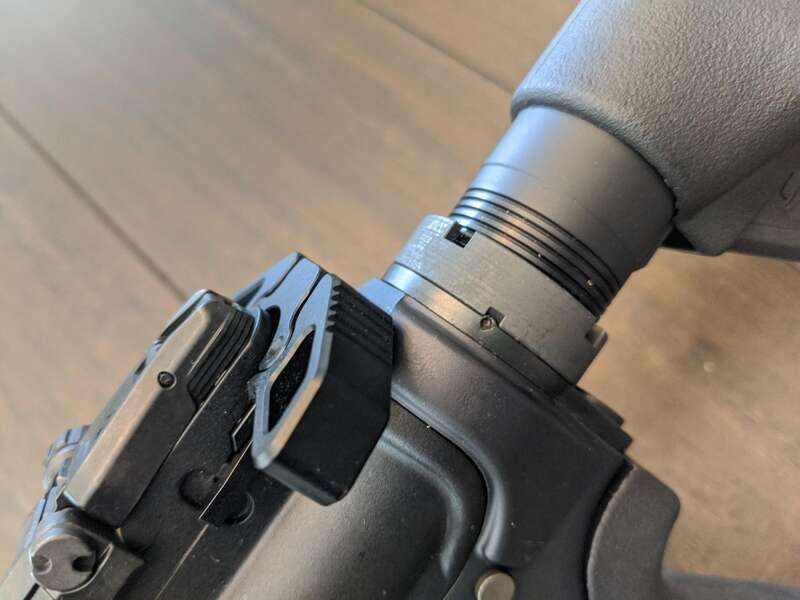Go  | New  | Find  | Notify  | Tools  | Reply  |  |
| Telecom Ronin |
Took a newly built AR pistol to the range to sight it in yesterday and after 10 rounds or so found the castle nut had loosened and the Kak brace was moving. I thought I had torqued it enough (used the proper tool as well)....guess not or maybe I need to stake the castle nut? Anyones have this issue and if so what was your solution | ||
|
Fighting the good fight |
I use several strikes from a spring-loaded center punch to stake my castle nuts. Takes less than a minute, and I've never had any of them loosen up. | |||
|
| Member |
Center punch. --------------------------- My hovercraft is full of eels. | |||
|
| semi-reformed sailor |
I use loctite. Just a drop will do. And it can be taken off if needed w/o marring the tube or the nut. "Violence, naked force, has settled more issues in history than has any other factor.” Robert A. Heinlein “You may beat me, but you will never win.” sigmonkey-2020 “A single round of buckshot to the torso almost always results in an immediate change of behavior.” Chris Baker | |||
|
| Member |
I resorted to that on my SBR build. I put in a IWC DQ End Plate. I don't know what it was made of. But it laughed off about a dozen hits with a center punch. So a single drop of loctite (blue) has kept it where it's supposed to be for years. Train how you intend to Fight Remember - Training is not sparring. Sparring is not fighting. Fighting is not combat. | |||
|
Member |
The torque spec of 38-42 ft-lb is wet, using an antiseize such as the spec'd Aeroshell 64 (33MS). Tightening it dry is not as tight as reaching the same torque with lubricated threads. A 5/32 center punch is pretty common, or the cheap auto center punch works for staking. Military spec is to stake in two locations. Any of my "counted on" guns are staked. The rest are I leave alone as I'm likely to have them apart before too long. | |||
|
| Member |
I never leave anything the way it is too long so I use green penetrating locktite 290 and it works fine. “So in war, the way is to avoid what is strong, and strike at what is weak.” | |||
|
| I kneel for my God, and I stand for my flag |
 | |||
|
The cake is a lie! |
I stake twice. I start off with a carbine scribe to get a dimple started, then use a center punch. A castle nut wrench takes it right off if you need to remove it and just buy a new plate. | |||
|
| Member |
Also a spring loaded center punch guy. It’s not moving. It’s also very easy to do. | |||
|
"Member" |
I never staked them. Don't use thread locker anymore either. I had one come loose once. I retightened it. I live on the edge. I also shoot rifles with un-staked gas keys and barrel nuts that aren't torqued to mil spec. I'm a dead man walking. _____________________________________________________ Sliced bread, the greatest thing since the 1911. | |||
|
Member |
I've been pretty happy with the PWS Ratchet castle nut & end plate. https://www.primaryweapons.com/product-url-6669  ...let him who has no sword sell his robe and buy one. Luke 22:35-36 NAV "Behold, I send you out as sheep in the midst of wolves; so be shrewd as serpents and innocent as doves." Matthew 10:16 NASV | |||
|
| Member |
Might be a great idea and Perfect execution but I’m not adding 5-7x the cost on this part to avoid like 5 seconds of staking or $.05 of locktite. Your priorities can be different of course, “So in war, the way is to avoid what is strong, and strike at what is weak.” | |||
|
Old Air Cavalryman |
I've only had this happen once. My very first AR, ( Olympic Arms ) had many issues. When the lock ring, ( this was an early to mid 90's AR, ) loosened up, my Dad showed me, ( I was a dumb 19 year old kid who didn't know much in the way of AR maintenance other than basic operator upkeep, ) how to apply a small amount of loctite and tighten it down with a spanner wrench. Never had a problem with it loosening up again, despite many thousands of rounds put through it by me and later, a friend who I sold it to. I've always manually staked castle nuts. It's just the way I was trained and practiced for the last couple decades. "Also I heard the voice of the Lord saying who shall I send, and who will go for us? Then said I, here am I, send me." | |||
|
| Left-Handed, NOT Left-Winged! |
I don't stake the nuts on my builds because I use aluminum endplates with titanium QD sockets (Radian). It's funny that the torque spec is supposed to be with lube because I have never seen any lube on various factory AR's. I just tighten dry to 40 ft-lbs. But I can easily loosen and add lube and retighten if I decide to, because they aren't staked. Most of the buffer tubes I use are the internally extended kind that capture the buffer detent in a "fork". So they will not back out even if the nut loosens up. | |||
|
Glorious SPAM! |
I'm a stake kind of guy. But then I'm also the guy who has a tube of Aeroshell 33MS grease on the shelf to lube the receiver extension and barrel nut. I torque the castle nut to the number in the TM (38-42 Ft.Lbs). (Just an FYI the torque on the HK M27 is 44 Ft.Lbs +/- 7, slightly different). I bought a castle nut tool from Specialized Armament years ago and it works great. I've been turning wrenches since I was ten on various things and I like having the right tools for the job. Is it necessary? Probably not. But I enjoy doing it and I have never had an issue. Done it on every AR I have built and I have never run into a problem. Now if I didn't stake would I have have had a problem? Probably not. But it is so easy though why not do it? I just put together two LMT MARS lower receivers (an -L and an -H) and I used the grease on the extensions and I staked them with a 1/8" center punch. On my Colt factory rifles I have noticed the moly grease on the barrel nut and receiver extension and the receiver extensions are all staked. (Also I just picked up a new FN A4 upper and it had the grease on the barrel nut. The grease has a smell to me and I notice it; the mechanic in me likes to taste POL's to identify them, the adult in me stopped that a while ago...so we rely on smell now). As for what the armorer TM's say..first pic is from the USMC M16/M4 manual (NOTE: the USMC manual had the same issue the Army TM had, they noted inch pounds when it was suppose to be foot pounds).  The next is from the M27 TM. Just a different torque spec but it still says to stake.  So to stake or not to stake...that is the question. Will you develop an issue if you don't? Most likely not. Will it stay in place if you do? Most likely will. | |||
|
Member |
Most "factory" AR's are built by individuals with less training than the posters in this thread. Just because someone is selling you a complete rifle doesn't mean it was done right, with quality parts, and will work and/or not beat itself to death in short order. The AR market is full of marketing gimmicks to sell you useless or poorly engineered products. Like the ratcheting end plate mentioned above; My circle of friends has a 100% failure rate using those, as the detent is marred during installation and after the first removal it no longer can hold proper tension and has become useless at its task of avoiding staking or threadlocker. The forked buffer tubes are another example. They work a bit better for install and remove some of the "guess work" one might have with extension timing, but then I had a rifle using one get a blown primer and lock the action open requiring removing the extension to free the BCG... except the tube is now captured internally with no way to get the thing apart... that was a fun time trying to get a screwdriver in the little gap I had to depress the retaining pin. | |||
|
| Powered by Social Strata |
| Please Wait. Your request is being processed... |
|
© SIGforum 2025